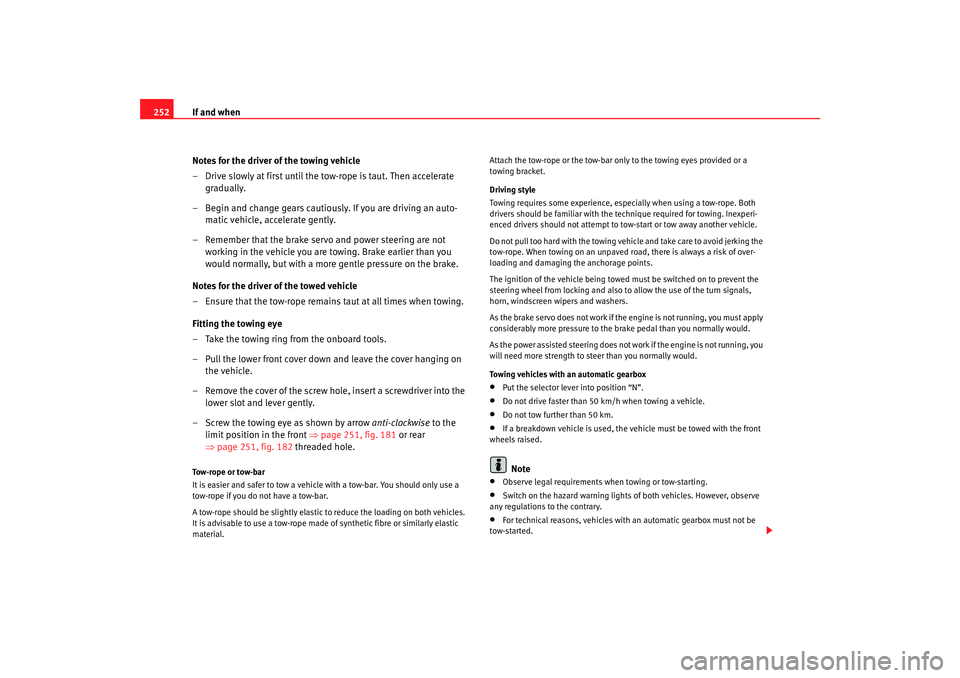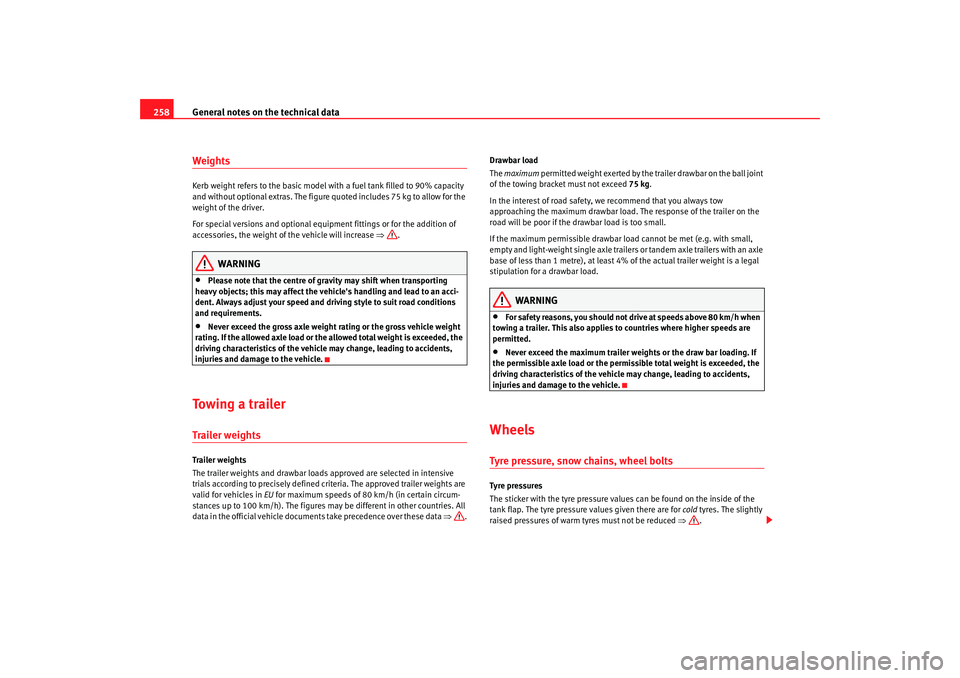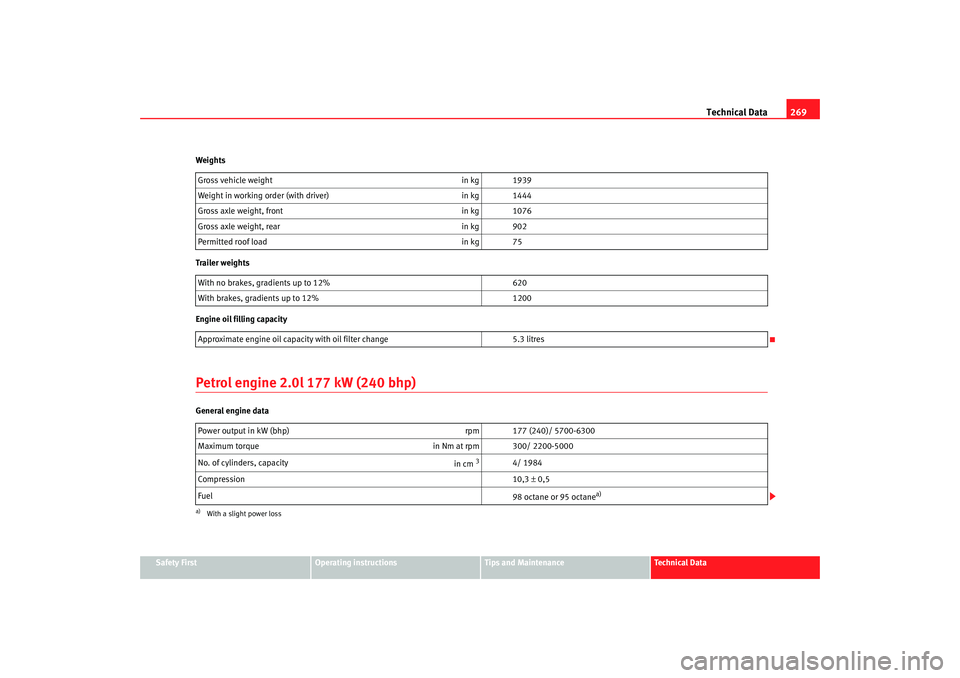light Seat Leon 5D 2006 Maintenance programme
[x] Cancel search | Manufacturer: SEAT, Model Year: 2006, Model line: Leon 5D, Model: Seat Leon 5D 2006Pages: 292, PDF Size: 8.86 MB
Page 252 of 292

If and when
250
WARNING
•
Please note the safety warnings referring to working in the engine
compartment ⇒page 198, “Working in the engine compartment”.
•
The battery providing assistance must have the same voltage as the flat
battery (12V) and approximately the same capacity (see imprint on
battery). Failure to comply could result in an explosion.
•
Never use jump leads when one of the batteries is frozen. Danger of
explosion! Even after the battery has thawed, battery acid could leak and
cause chemical burns. If a battery freezes, it should be replaced.
•
Keep sparks, flames and lighted cigarettes away from batteries, danger
of explosion. Failure to comply could result in an explosion.
•
Observe the instructions provided by the manufacturer of the jump
leads.
•
Do not connect the negative cable from the other vehicle directly to the
negative terminal of the flat battery. The gas emitted from the battery could
be ignited by sparks. Danger of explosion.
•
Do not attach the negative cable from the other vehicle to parts of the
fuel system or to the brake line.
•
The non-insulated parts of the battery clamps must not be allowed to
touch. The jump lead atta ched to the positive battery terminal must not
touch metal parts of the vehicle, this can cause a short circuit.
•
Position the leads in such a way that they cannot come into contact
with any moving parts in the engine compartment.
•
Do not bend over the batteries. This could result in chemical burns.Note
The vehicles must not touch each other, otherwise electricity could flow as
soon as the positive terminals are connected.
leon_ingles Seite 250 Donnerstag, 24. August 2006 1:56 13
Page 254 of 292

If and when
252
Notes for the driver of the towing vehicle
– Drive slowly at first until the to w-rope is taut. Then accelerate
gradually.
– Begin and change gears cautiously. If you are driving an auto- matic vehicle, accelerate gently.
– Remember that the brake servo and power steering are not working in the vehicle you are towing. Brake earlier than you
would normally, but with a more gentle pressure on the brake.
Notes for the driver of the towed vehicle
– Ensure that the tow-rope remains taut at all times when towing.
Fitting the towing eye
– Take the towing ring from the onboard tools.
– Pull the lower front cover down and leave the cover hanging on the vehicle.
– Remove the cover of the screw hole, insert a screwdriver into the lower slot and lever gently.
– Screw the towing eye as shown by arrow anti-clockwise to the
limit position in the front ⇒page 251, fig. 181 or rear
⇒ page 251, fig. 182 threaded hole.Tow-rope or tow-bar
It is easier and safer to tow a vehicle with a tow-bar. You should only use a
tow-rope if you do not have a tow-bar.
A tow-rope should be slightly elastic to reduce the loading on both vehicles.
It is advisable to use a tow-rope made of synthetic fibre or similarly elastic
material. Attach the tow-rope or the tow-bar only to the towing eyes provided or a
towing bracket.
Driving style
Towing requires some experience, espec
ially when using a tow-rope. Both
drivers should be familiar with the te chnique required for towing. Inexperi-
enced drivers should not attempt to tow-start or tow away another vehicle.
Do not pull too hard with the towing vehicle and take care to avoid jerking the
tow-rope. When towing on an unpaved road, there is always a risk of over-
loading and damaging the anchorage points.
The ignition of the vehicle being towed must be switched on to prevent the
steering wheel from locking and also to allow the use of the turn signals,
horn, windscreen wipers and washers.
As the brake servo does not work if the engine is not running, you must apply
considerably more pressure to the brake pedal than you normally would.
As the power assisted steering does not work if the engine is not running, you
will need more strength to steer than you normally would.
Towing vehicles with an automatic gearbox
•
Put the selector lever into position “N”.
•
Do not drive faster than 50 km/h when towing a vehicle.
•
Do not tow further than 50 km.
•
If a breakdown vehicle is used, the vehicle must be towed with the front
wheels raised.Note
•
Observe legal requirements when towing or tow-starting.
•
Switch on the hazard warning lights of both vehicles. However, observe
any regulations to the contrary.
•
For technical reasons, vehicles with an automatic gearbox must not be
tow-started.
leon_ingles Seite 252 Donnerstag, 24. August 2006 1:56 13
Page 260 of 292

General notes on the technical data
258WeightsKerb weight refers to the basic model with a fuel tank filled to 90% capacity
and without optional extras. The figure quoted includes 75 kg to allow for the
weight of the driver.
For special versions and optional equipment fittings or for the addition of
accessories, the weight of the vehicle will increase ⇒.
WARNING
•
Please note that the centre of gravity may shift when transporting
heavy objects; this may affect the vehi cle's handling and lead to an acci-
dent. Always adjust your speed and dr iving style to suit road conditions
and requirements.
•
Never exceed the gross axle weight rating or the gross vehicle weight
rating. If the allowed axle load or the allowed total weight is exceeded, the
driving characteristics of the vehicle may change, leading to accidents,
injuries and damage to the vehicle.
To w i n g a t r a i l e rTrailer weightsTrailer weights
The trailer weights and drawbar loads approved are selected in intensive
trials according to precisely defined criteria. The approved trailer weights are
valid for vehicles in EU for maximum speeds of 80 km/h (in certain circum-
stances up to 100 km/h). The figures may be different in other countries. All
data in the official vehicle documents take precedence over these data ⇒. Drawbar load
The
maximum permitted weight exerted by the trailer drawbar on the ball joint
of the towing bracket must not exceed 75 kg.
In the interest of road safety, we recommend that you always tow
approaching the maximum drawbar load. The response of the trailer on the
road will be poor if th e drawbar load is too small.
If the maximum permissible drawbar load cannot be met (e.g. with small,
empty and light-weight single axle trailers or tandem axle trailers with an axle
base of less than 1 metre), at least 4% of the actual trailer weight is a legal
stipulation for a drawbar load.
WARNING
•
For safety reasons, you should not drive at speeds above 80 km/h when
towing a trailer. This also applies to countries where higher speeds are
permitted.
•
Never exceed the maximum trailer weights or the draw bar loading. If
the permissible axle load or the perm issible total weight is exceeded, the
driving characteristics of the vehicle may change, leading to accidents,
injuries and damage to the vehicle.
WheelsTyre pressure, snow chains, wheel boltsTyre pressures
The sticker with the tyre pressure values can be found on the inside of the
tank flap. The tyre pressure values given there are for cold tyres. The slightly
raised pressures of warm tyres must not be reduced ⇒.
leon_ingles Seite 258 Donnerstag, 24. August 2006 1:56 13
Page 265 of 292

Technical Data263
Safety First
Operating instructions
Tips and Maintenance
Te c h n i c a l D a t a
Trailer weights
Engine oil filling capacity
Petrol engine 2.0 110 kW (150 bhp). ManualGeneral engine data
Performance figures
With no brakes, gradients up to 12%
640
With brakes, gradients up to 12% 1200
Approximate engine oil capacity with oil filter change 4.8 litres
Power output in kW (bhp) rpm 110 (150)/ 6000
Maximum torque in Nm at rpm 200/ 3500
No. of cylinders, capacity in cm
3
4/ 1984
Compression 11,5-0,5
Fuel 98 octane or 95 octane
a)
a)Slight power lossMaximum speedin km/h 210
Acceleration from 0-80 km/h in sec. 6,0
Acceleration from 0-100 km/h in sec. 8,8
leon_ingles Seite 263 Donnerstag, 24. August 2006 1:56 13
Page 266 of 292

Technical Data
264Weights
Trailer weights
Engine oil filling capacityPetrol engine 2.0 110 kW (150 bhp). AutomaticGeneral engine data Gross vehicle weight
in kg 1830
Weight in working order (with driver) in kg 1335
Gross axle weight, front in kg 989
Gross axle weight, rear in kg 883
Permitted roof load in kg 75
With no brakes, gradients up to 12% 660
With brakes, gradients up to 12% 1400
Engine oil capacity with oil filter change. 5.3 litres
Power output in kW (bhp) rpm 110 (150)/ 6000
Maximum torque in Nm at rpm 200/ 3500
No. of cylinders, capacity in cm
3
4/ 1984
Compression 11,5-0,5
Fuel 98 octane or 95 octane
a)
a)With a slight power loss
leon_ingles Seite 264 Donnerstag, 24. August 2006 1:56 13
Page 268 of 292

Technical Data
266Petrol engine 2.0l 136 kW (185 bhp)General engine data
Performance figures
Weights
Trailer weights Power output in kW (bhp)
rpm 136 (185)/ 5100-6000
Maximum torque in Nm at rpm 270/ 1800-5000
No. of cylinders, capacity in cm
3
4/ 1984
Compression 10,3 ± 0,5
Fuel 98 octane or 95 octane
a)
a)With a slight power lossMaximum speedin km/h 221
Acceleration from 0-80 km/h in sec. 5,5
Acceleration from 0-100 km/h in sec. 7,8
Gross vehicle weight in kg 1904
Weight in working order (with driver) in kg 1409
Gross axle weight, front in kg 1050
Gross axle weight, rear in kg 896
Permitted roof load in kg 75
With no brakes, gradients up to 12% 700
With brakes, gradients up to 12% 1400
leon_ingles Seite 266 Donnerstag, 24. August 2006 1:56 13
Page 269 of 292

Technical Data267
Safety First
Operating instructions
Tips and Maintenance
Te c h n i c a l D a t a
Engine oil filling capacity
Petrol engine 2.0l 147 kW (200 bhp). ManualGeneral engine data
Performance figures
Weights
Approximate engine oil capacity with oil filter change
5.3 litres
Power output in kW (bhp) rpm 147 (200)/ 5100-6000
Maximum torque in Nm at rpm 280/ 1800-5000
No. of cylinders, capacity in cm
3
4/ 1984
Compression 10,3 ± 0,5
Fuel 98 octane or 95 octane
a)
a)With a slight power lossMaximum speedin km/h 229
Acceleration from 0-80 km/h in sec. 5,2
Acceleration from 0-100 km/h in sec. 7,3
Gross vehicle weight in kg 1904
Weight in working order (with driver) in kg 1409
Gross axle weight, front in kg 1046
Gross axle weight, rear in kg 897
Permitted roof load in kg 75
leon_ingles Seite 267 Donnerstag, 24. August 2006 1:56 13
Page 270 of 292

Technical Data
268Trailer weights
Engine oil filling capacityPetrol engine 2.0l 147 kW (200 bhp). AutomaticGeneral engine data
Performance figures With no brakes, gradients up to 12%
700
With brakes, gradients up to 12% 1400
Approximate engine oil capacity with oil filter change 5.3 litres
Power output in kW (bhp) rpm 147 (200)/ 5100-6000
Maximum torque in Nm at rpm 280/ 1800-5000
No. of cylinders, capacity in cm
3
4/ 1984
Compression 10,3 ± 0,5
Fuel 98 octane or 95 octane
a)
a)With a slight power lossMaximum speedin km/h 229
Acceleration from 0-80 km/h in sec. 5,2
Acceleration from 0-100 km/h in sec. 7,2
leon_ingles Seite 268 Donnerstag, 24. August 2006 1:56 13
Page 271 of 292

Technical Data269
Safety First
Operating instructions
Tips and Maintenance
Te c h n i c a l D a t a
Weights
Trailer weights
Engine oil filling capacity
Petrol engine 2.0l 177 kW (240 bhp)General engine data
Gross vehicle weight
in kg 1939
Weight in working order (with driver) in kg 1444
Gross axle weight, front in kg 1076
Gross axle weight, rear in kg 902
Permitted roof load in kg 75
With no brakes, gradients up to 12% 620
With brakes, gradients up to 12% 1200
Approximate engine oil capacity with oil filter change 5.3 litres
Power output in kW (bhp) rpm 177 (240)/ 5700-6300
Maximum torque in Nm at rpm 300/ 2200-5000
No. of cylinders, capacity in cm
3
4/ 1984
Compression 10,3 ± 0,5
Fuel 98 octane or 95 octane
a)
a)With a slight power loss
leon_ingles Seite 269 Donnerstag, 24. August 2006 1:56 13
Page 281 of 292

Technical Data279
Safety First
Operating instructions
Tips and Maintenance
Te c h n i c a l D a t a
Dimensions and capacitiesDimensions
Capacities
Tyre pressureLength, width
4,315 mm/ 1,768 mm
Height at kerb weight 1,459 mm
Front and rear projection 949 mm/ 788mm
Wheelbase 2,578 mm
Turning circle 10.7 m
Track width
a)
a)This data will change depending on the type of wheel rim.
Front Rear
1,525 mm 1,509 mm
1,533 mm 1,517 mm
Fuel tank 55 l. Reserve 7 l.
Windscreen washer fluid container with headlight washer 3 l/ 5.5 l
Summer-grade tyres:
The correct tyre pressure can be seen on the sticker on the inside of the tank flap.
Winter tyres:
The pressure of these tyres is the same as the summer tyre pressure plus 0.2 bar.
leon_ingles Seite 279 Donnerstag, 24. August 2006 1:56 13